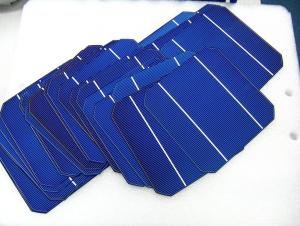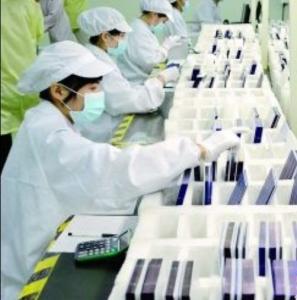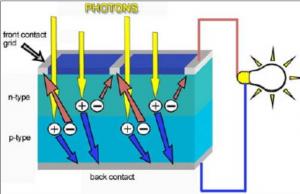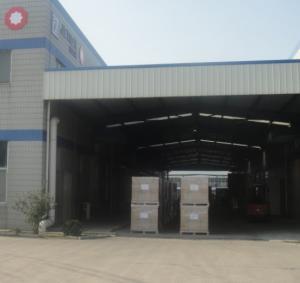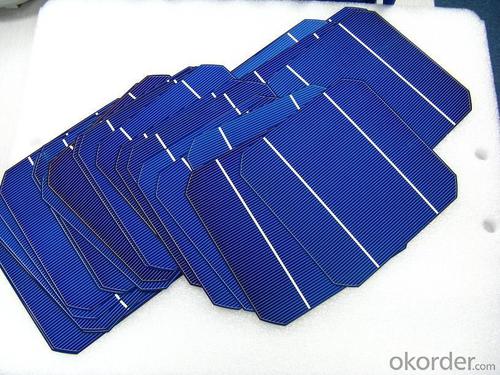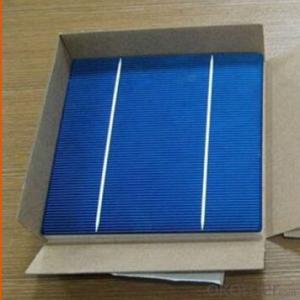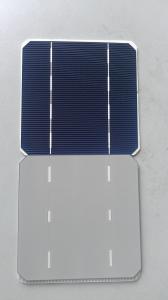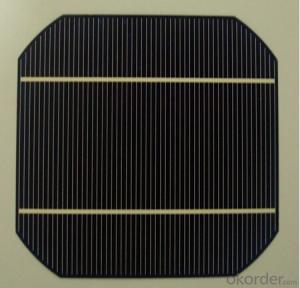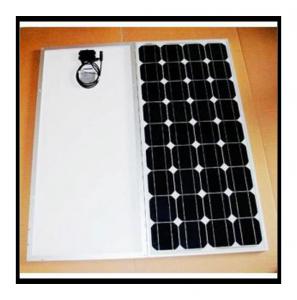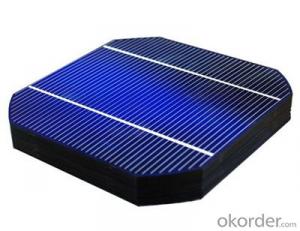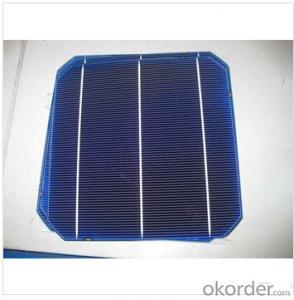Third Generation Solar Cells - Mono Solar Cell 125mm x 125mm x 0.5mm
- Loading Port:
- China main port
- Payment Terms:
- TT or LC
- Min Order Qty:
- 40000 watt
- Supply Capability:
- 100000 watt/month
OKorder Service Pledge
OKorder Financial Service
You Might Also Like
Details Of Mono Solar Cell 125mm
Specifications Of Mono Solar Cell 125mm
1.Mechanical data and design
Format | 125 mm × 125 mm ± 0.5 mm |
Thickness | 210 μm ± 40 μm |
Front(-) | 1.6 mm bus bars (silver),blue anti-reflection coating (silicon nitride) |
Back (+) | 2.5 mm wide soldering pads (silver) back surface field (aluminium) |
2.Temperature Coefficient of Cells
Voc. Temp . coef.%/K | -0.35%/K |
Isc . Temp . coef.%/K | +0.024%/K |
Pm. Temp. coef.%/K | -0.47%/K |
3.Electrical Characteristic
Efficiency(%) | Pmpp (W) | Umpp (V) | Impp (A) | Uoc (V) | Isc (A) | FF (%) |
18.35 | 2.841 | 0.532 | 5.342 | 0.631 | 5.67 | 79.41% |
18.20 | 2.817 | 0.53 | 5.319 | 0.631 | 5.64 | 79.16% |
18.05 | 2.794 | 0.527 | 5.301 | 0.63 | 5.63 | 78.77% |
17.90 | 2.771 | 0.527 | 5.259 | 0.629 | 5.62 | 78.39% |
17.75 | 2.748 | 0.526 | 5.224 | 0.629 | 5.61 | 77.88% |
17.60 | 2.725 | 0.524 | 5.201 | 0.629 | 5.59 | 77.50% |
17.45 | 2.702 | 0.52 | 5.196 | 0.629 | 5.586 | 76.90% |
17.30 | 2.678 | 0.516 | 5.183 | 0.626 | 5.577 | 76.71% |
17.15 | 2.655 | 0.513 | 5.175 | 0.623 | 5.565 | 76.58% |
17.00 | 2.632 | 0.51 | 5.161 | 0.622 | 5.559 | 76.12% |
16.75 | 2.593 | 0.508 | 5.103 | 0.615 | 5.477 | 76.98% |
16.50 | 2.555 | 0.506 | 5.047 | 0.608 | 5.396 | 77.88% |
4.Intensity Dependence
Advantage Of Mono Solar Cell 125mm
1: high quality cell, Level A cell (16.50%—18.35%)
2: Dimensione:125*125mm Diagonal:150mm / 165mm
Dimensione:156*156mm Diagonal:200mm
3: Qualified certification: TUV,CE certification.
4: Warranty: five years for whole unit
Usage/Application Of Mono Solar Cell 125mm
Packaging & Delivery Of Mono Solar Cell 125mm | |
Packaging Detai | Packaging Detail:Export Carton and Pallet or under customer request. |
Delivery Detail:10-20days | |
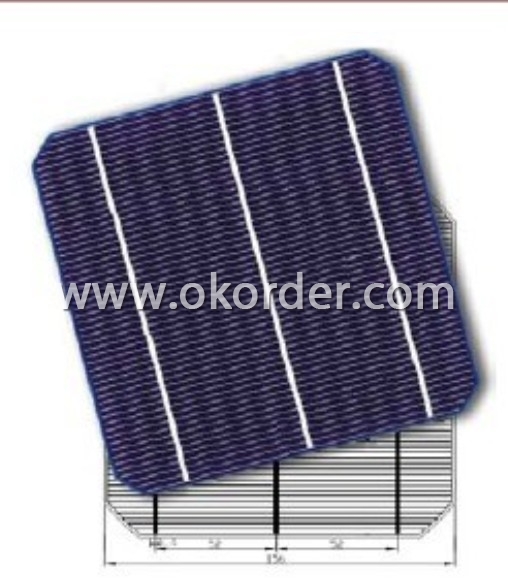
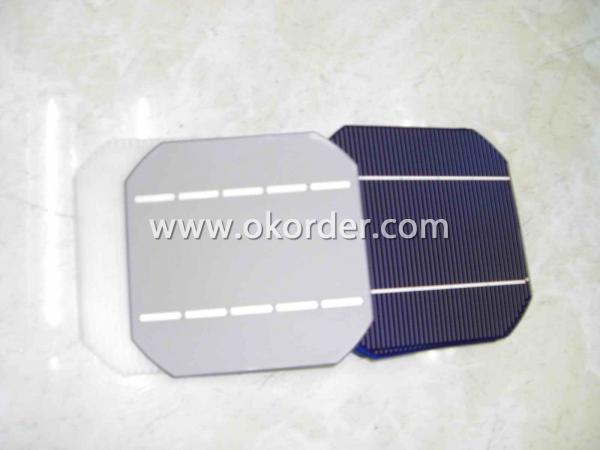
Converting the sun’s radiation directly into electricity is done by solar cells. These cells are made of semiconducting materials similar to those used in computer chips. When sunlight is absorbed by these materials, the solar energy knocks electrons loose from their atoms, allowing the electrons to flow through the material to produce electricity. This process of converting light (photons) to electricity (voltage) is called the photovoltaic effect.
When photons are absorbed by matter in the solar cell, their energy excites electrons higher energy states where the electrons can move more freely. The perhaps most well-known example of this is the photoelectric effect, where photons give electrons in a metal enough energy to escape the surface. In an ordinary material, if the electrons are not given enough energy to escape, they would soon relax back to their ground states. In a solar cell however, the way it is put together prevents this from happening. The electrons are instead forced to one side of the solar cell, where the build-up of negative charge makes a current flow through an external circuit. The current ends up at the other side (or terminal) of the solar cell, where the electrons once again enter the ground state, as they have lost energy in the external circuit.
Solar cells, which were originally developed for space applications in the 1950s, are used in consumer products (such as calculators or watches), mounted on roofs of houses or assembled into large power stations. Today, the majority of photovoltaic modules are used for grid-connected power generation, but a smaller market for off-grid power is growing for remote areas and developing countries.
Given the enormous potential of solar energy, photovoltaics may well become a major source of clean electricity in the future. However, for this to happen, the electricity generation costs for PV systems need to be reduced and the efficiency of converting sunlight into electricity needs to increase. To achieve this, the Commission supports photovoltaics development since many years by funding research projects and facilitating cooperation between stakeholders.
- Q: How long does it take for solar cells to pay for themselves?
- The payback period for solar cells typically varies between 5 to 15 years, depending on factors like the initial cost, location, energy consumption, and available incentives.
- Q: Can solar cells be used in emergency lighting?
- Yes, solar cells can be used in emergency lighting. Solar-powered emergency lights are designed to provide illumination during power outages or emergencies by utilizing solar panels to convert sunlight into electricity, which is then stored in batteries for later use. This makes them a reliable and sustainable option for emergency lighting solutions.
- Q: Can solar cells be used in space heating systems?
- Yes, solar cells can be used in space heating systems. Solar cells can convert sunlight into electricity, which can then be used to power heating systems. This can be done through the use of solar thermal collectors or by converting the electricity generated by the solar cells into heat using electric heaters.
- Q: Can solar cells be used for cooking?
- Yes, solar cells can be used for cooking, but not directly. Solar cells generate electricity from sunlight, which can then be used to power electric stoves or other cooking appliances.
- Q: Can solar cells be used in aviation or aerospace applications?
- Yes, solar cells can be used in aviation or aerospace applications. They are commonly used to power satellites, space probes, and unmanned aerial vehicles (UAVs) due to their ability to convert sunlight into electricity. Solar cells can provide a reliable and sustainable source of power in remote and high-altitude environments.
- Q: Can the solar powered cells really work better than the normal cells?
- There is no doubt that the solar powered cells work better than the normal cells, the only disadvantage is the cost of making it.
- Q: Can solar cells be used to power agricultural irrigation systems?
- Yes, solar cells can indeed be used to power agricultural irrigation systems. Solar power provides a sustainable and reliable source of energy to pump water for irrigation, helping farmers reduce their dependence on fossil fuels and electricity grids. This approach is particularly beneficial in remote areas with limited access to conventional power sources.
- Q: How do solar cells impact energy consumption patterns?
- Solar cells impact energy consumption patterns by providing a renewable and clean source of electricity. They reduce reliance on traditional fossil fuels, decrease greenhouse gas emissions, and promote sustainable energy practices. Solar cells enable individuals, businesses, and communities to generate their own power, leading to a more decentralized and resilient energy system. Additionally, solar energy contributes to a more balanced and diversified energy mix, reducing the strain on conventional power grids and enhancing energy security.
- Q: How is the efficiency of a solar cell calculated?
- The efficiency of a solar cell is calculated by dividing the maximum power output of the solar cell by the total amount of solar energy it receives.
- Q: Can solar cells be used for powering drones?
- Yes, solar cells can be used for powering drones. Solar-powered drones utilize photovoltaic cells to convert sunlight into electricity, which can then be used to power the drone's motor and other systems. This renewable energy source allows for longer flight times and reduced reliance on traditional fuel sources.
1. Manufacturer Overview
| Location | SanShui City, Guang Dong, China. |
| Year Established | 2009 |
| Annual Output Value | Above 10 billion RMB |
| Main Markets | Mid East;Western Europe;North America;Southeast Asia |
| Company Certifications | TUV ISO9001;SGS |
2. Manufacturer Certificates
| a) Certification Name | |
| Range | |
| Reference | |
| Validity Period |
3. Manufacturer Capability
| a) Trade Capacity | |
| Nearest Port | Zhuhai, Foshan |
| Export Percentage | 0.4 |
| No.of Employees in Trade Department | about 600 |
| Language Spoken: | English;Chinese; |
| b) Factory Information | |
| Factory Size: | 66666.7m2 |
| No. of Production Lines | 12 |
| Contract Manufacturing | OEM Service Offered;Design Service Offered |
| Product Price Range | USD 0.3-0.45/Wp |
Send your message to us
Third Generation Solar Cells - Mono Solar Cell 125mm x 125mm x 0.5mm
- Loading Port:
- China main port
- Payment Terms:
- TT or LC
- Min Order Qty:
- 40000 watt
- Supply Capability:
- 100000 watt/month
OKorder Service Pledge
OKorder Financial Service
Similar products
Hot products
Hot Searches
Related keywords
